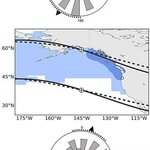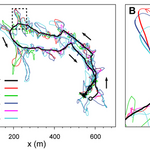Ecology & Zoology

We may have too much plastic in the environment but creatures that lack a Mother Jones to tell them how awful things are adapt and overcome; two urban bee species have been caught making nests out of plastic waste.
Although lots of research has shown adverse impacts of the material on species and the ecosystem, few scientists have documented insects 'making lemonade out of lemons' and adapting to a plastic-rich environment. It's an important discovery because it shows bees' resourcefulness and flexibility in adapting to a human-dominated world, says lead author Scott MacIvor, a doctoral…

Only one species of hoatzins exists in South America today - or anywhere else.
Opisthocomus hoazin, also known as the Stinkbird or Canje Pheasant, has an unclear evolutionary history but was assumed to have originated in South America.
Not so, it seems. The oldest known fossils of Hoatzin ancestors reveal that these birds existed around 34 million years ago in Europe, according to paleornithologists at the Senckenberg Gesellschaft für Naturforschung and Flinders University in Adelaide.
The oldest fossils attributed to hoatzins were found more than 100 years ago near Paris but it's only…

A lot of coffee is grown on and around Kilimanjaro, which towers almost 20,000 feet in the air.
The most traditional form of cultivation can be found in the gardens of the Chagga people. In some areas, coffee trees and other crop plants still grow in the shade of banana trees but most coffee is grown on plantations, which still feature a large number of shade trees.
However, Africans reliant on coffee for income have gradually replaced legacy coffee varietals, which prefer shade, with others that are more resistant to fungi and can also grow in the sun.
Yet the coffee may not be…

Last year, a group of researchers created a correlation between the migration patterns of ocean salmon and the Earth's magnetic field, suggesting it may help explain how the fish can navigate across thousands of miles of water to find their river of origin.
Other researchers did it with carp in buckets too.
A series of experiments at the Oregon Hatchery Research Center in the Alsea River basin have confirmed this, say the researchers. They exposed hundreds of juvenile Chinook salmon to different magnetic fields that exist at the latitudinal extremes of their oceanic range. Fish…

Insects taste through hair-like structures on the body called sensilla. Sensilla contain receptor nerve cells, each of which is sensitive to a particular substance.
In insects like the honeybee, sensilla are found on the mouthparts, antenna and the tarsi – the end part of the legs. Honeybees weigh information from both front tarsi to decide whether to feed, finds a new study on the ability of honeybees to taste with claws on their forelegs, which reveals details on how this information is processed.
Using hundreds of honeybees, sugary, bitter and salty solutions were applied to…

Organic farms support more biodiversity, supporting 34% more plant, insect and animal species than conventional farms, according to a new paper. For pollinators such as bees, the number of different species was 50% higher on organic farms, although the authors stress that the study only looked at 'species richness'.
They looked at data from 94 previous studies covering 184 farm sites dating back to 1989 and found that this effect has remained stable over time and shows no signs of decreasing.
"Species richness tells us how many different species there are but does not say anything about…

While marketing campaigns against farming claim otherwise, agricultural practices can have a broad beneficial influence on bird abundance and diversity. Row crops are considered to be bad for wildlife but a new study shows that isn't necessarily true.
The report finds that several bird species – some of them rare – are making extensive use of soybean fields in Illinois.
The team spent about 13 weeks each spring and summer in 2011 and 2012 scouring a total of 24 fields (12 per year) in two counties in Central Illinois. The fields were 18 to 20 hectares (44-49 acres) on average, and the…

North American bats are facing a tough new millennium. 600,000 per year are already killed due to government subsidies of wind energy and so far 7 million have died due to White Nose Syndrome.
While we are likely stuck with wind energy for the foreseeable future, there is hope for White Nose Syndrome. Scientists have discovered that the deadly WNS fungus can survive in caves with or without the presence of bats.
Our flying mammal friends serve as food plant pollinators and they keep the insect population under control. They even have value in medical research, particularly as it…

Yield is economically important in field corn production, and there is no question that has been a success, but sweet corn has an additional metric for being considered a win. It's reported that crop yield responses due to sweet corn research are actually helpful to the industry, but are they?
Writing
in Field Crops Research, Marty Williams, a USDA-ARS ecologist and University of Illinois crop sciences researcher, analyzes results after collecting and studying sweet corn data representing 31 hybrids across 22 locations in Illinois over an 8-year period. The result: A disconnect in what…

A new paper has demonstrated the power of path tracking to measure social behavior and automatically determine dogs' personalities.
How dogs behave during walks reveals a lot about traits such as trainability, controllability, aggression, age and dominance. Dogs that consistently took the lead were more responsive to training, more controllable, older and more aggressive than the dogs that tended to follow.
Dogs that led more often had higher dominance ranks in everyday situations, assessed by a dominance questionnaire.
"The dominance questionnaire tells us the pecking order of dog groups…